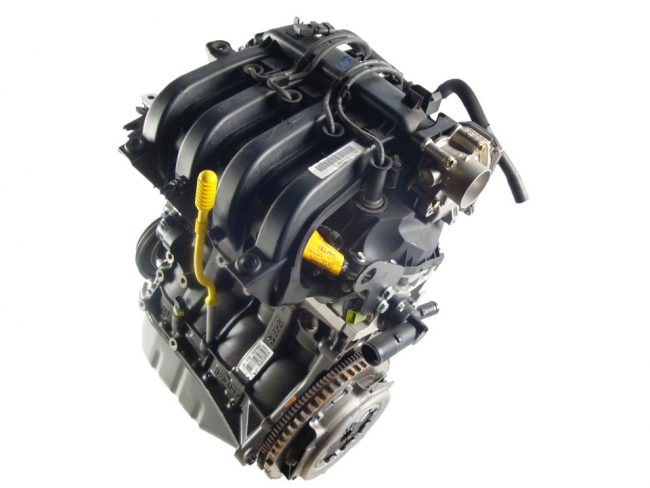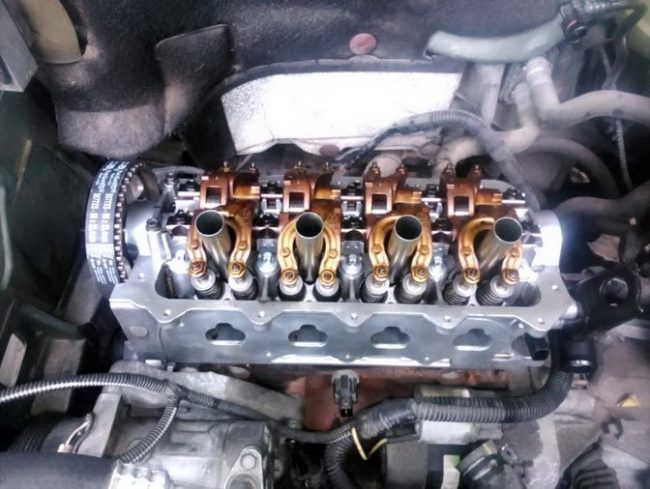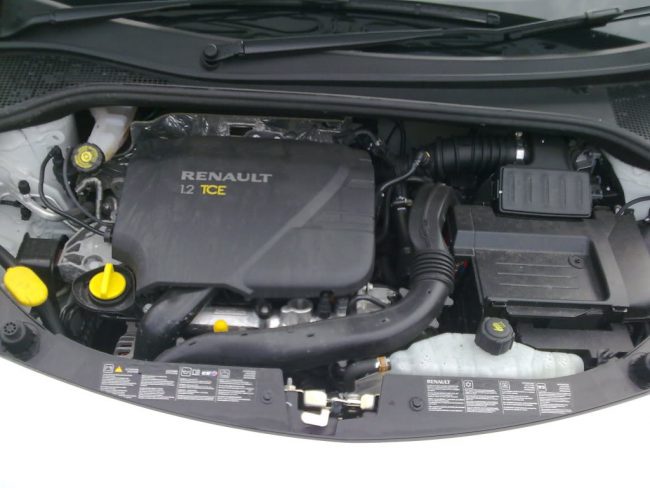
Renault D4F, D4Ft engines
Content
In the early 2000s, French engine builders introduced another power unit for small cars of the Renault automaker. The motor is developed on the basis of the successfully proven D7F.
Description
The D4F engine was developed and put into production in 2000. Produced at the plant of the Renault car concern in Bursa (Turkey) until 2018. The peculiarity was that it was not officially sold in Russia.

D4F is a 1,2-liter gasoline in-line four-cylinder aspirated engine with a capacity of 75 hp with a torque of 107 Nm.
There was a derated version of the motor. Its power was 10 hp less, and the torque remained almost the same - 105 Nm.
D4F was installed on Renault cars:
- Clio (2001-2018);
- Twingo (2001-2014);
- Kangoo (2001-2005);
- Mode (2004-2012);
- Symbol (2006-2016);
- Sandero (2014-2017);
- Logan (2009-2016).
The engine was equipped with one camshaft for 16 valves. There is no mechanism for adjusting the valve timing, and there is also no idle speed controller. The thermal clearance of the valves is adjusted manually (there are no hydraulic compensators).
Another feature is a single high-voltage ignition coil for four candles.

Differences between D4Ft and D4F
The D4Ft engine was released from 2007 to 2013. The D4F differed from the base model by the presence of a turbine with an intercooler and a modern electronic “stuffing”. In addition, the CPG received minor changes (the units of the connecting rod and piston group were reinforced, oil nozzles were installed to cool the pistons).
These changes made it possible to remove 100-103 hp from the engine. With. with a torque of 145-155 Nm.
An operational feature of the engine is the increased demands on the quality of fuels and lubricants.

The motor was used on Clio III, Modus I, Twingo II and Wind I cars from 2007 to 2013.
Car owners note the low starting qualities of the engine at low temperatures.
Technical specifications
| Manufacturer | Renault Group |
| Engine volume, cm³ | 1149 |
| Power, HP | 75 at 5500 rpm (65)* |
| Torque, Nm | 107 at 4250 rpm (105)* |
| Compression ratio | 9,8 |
| Cylinder block | cast iron |
| Cylinder head | aluminum |
| Cylinder diameter, mm | 69 |
| The piston stroke, mm | 76,8 |
| The order of the cylinders | 1-3-4-2 |
| Number of valves per cylinder | 4 (SOHC) |
| Timing drive | belt |
| Hydraulic compensators | no |
| Turbocharging | no |
| Fuel system | multi-point injection, distributed injection |
| Fuel | gasoline AI-95 |
| Environmental standards | Euros 5 (4)* |
| Resource, outside. km | 220 |
| Location | transverse |
*numbers in parentheses are for the derated version of the engine.
What do modifications mean?
For 18 years of production, the internal combustion engine has been repeatedly improved. The changes mainly affected the technical characteristics, the basic version of the D4F remained unchanged.
So, in 2005, the D4F 740 engine entered the market. Its power was increased by changing the geometry of the camshaft cams. The earlier 720 version featured a slightly redesigned intake manifold and larger air filter.
In addition, there were differences in mounting the motor on a specific car model.
| Engine code | Power | Torque | Compression ratio | Year of construction | Installed |
|---|---|---|---|---|---|
| D4F702 | 75 hp at 5500 rpm | 105 Nm | 9,8 | 2001-2012 | Renault Twingo |
| D4F706 | 75 hp at 5500 rpm | 105 Nm | 9,8 | 2001-2012 | Renault Clio I, II |
| D4F708 | 60 hp at 5500 rpm | 100 Nm | 9,8 | 2001-2007 | Renault Twingo |
| D4F712 | 75 hp at 5500 rpm | 106 Nm | 9,8 | 2001-2007 | Kangoo I, Clio I, II, Thalia I |
| D4F714 | 75 hp at 5500 rpm | 106 Nm | 9,8 | 2003-2007 | Kangoo I, Clio I, II |
| D4F716 | 75 hp at 5500 rpm | 106 Nm | 9,8 | 2001-2012 | Clio II, Kango II |
| D4F722 | 75 hp at 5500 rpm | 105 Nm | 9,8 | 2001-2012 | Clio II |
| D4F728 | 75 hp at 5500 rpm | 105 Nm | 9,8 | 2001-2012 | Clio II, Symbol II |
| D4F730 | 75 hp at 5500 rpm | 106 Nm | 9,8 | 2003-2007 | Kangoo I |
| D4F740 | 65-75 hp | 200 Nm | 9,8 | 2005-n. vr. | Clio III, IV, Modus I |
| D4F764 | 78 hp at 5500 rpm | 108 Nm | 9.8-10,6 | 2004-2013 | Clio III, Modus I, Twingo II |
| D4F770 | 75 hp at 5500 rpm | 107 Nm | 9,8 | 2007-2014 | Twingo ii |
| D4F772 | 75 hp at 5500 rpm | 107 Nm | 9,8 | 2007-2012 | Twingo ii |
| D4F 780* | 100 hp at 5500 rpm | 152 Nm | 9,5 | 2007-2013 | Twingo II, Wind I |
| D4F 782* | 102 hp at 5500 rpm | 155 Nm | 9,5 | 2007-2014 | Twingo II, Wind I |
| D4F 784* | 100 hp at 5500 rpm | 145 Nm | 9,8 | 2004-2013 | Clio III, Modus I |
| D4F 786* | 103 hp at 5500 rpm | 155 Nm | 9,8 | 2008-2013 | Clio III, Modus, Grand Modus |
* modifications of the D4Ft version.
Reliability, weaknesses, maintainability
Reliability
The D4F engine is highly reliable. Simplicity of design, reduced requirements for the quality of fuels and lubricants and increased mileage up to 400 thousand km before overhaul with timely maintenance of the motor confirm what has been said.
The entire D4F ICE series is highly resistant to oil burns. And this is a serious bid for the durability of the unit.
Many car owners claim that the engine life exceeds 400 thousand km if the service intervals for maintenance are observed while using original consumables and parts.
Weak spots
Weaknesses traditionally include electrical failures. The fault is not durable ignition coil and camshaft position sensor.
In the event of a broken timing belt valve bend inevitable.
Increased noise when the engine is running at idle speed. The most likely cause of such a malfunction lies in unadjusted valves.
Oil leaks through various seals.
At the same time, it should be noted that "weak spots" are easily eliminated if they are detected in a timely manner. Except electrical. Its repair is carried out at the service station.
Maintainability
The cast-iron block assumes the possibility of boring cylinders to the desired repair size, i.e. it is possible to carry out a complete overhaul of the internal combustion engine.
There are no problems with the purchase of spare parts. They are available in any assortment in specialized stores. True, car owners note their high cost.
Often, instead of repairing an old motor, it is easier (and cheaper) to purchase a contract one. Its average cost is about 30 thousand rubles. The price of a complete overhaul with the use of spare parts can exceed 40 thousand.
In general, the D4F engine turned out to be successful. Car owners note its cost-effectiveness in operation and ease of maintenance. The motor is distinguished by durability and a long mileage resource with timely and high-quality maintenance.

